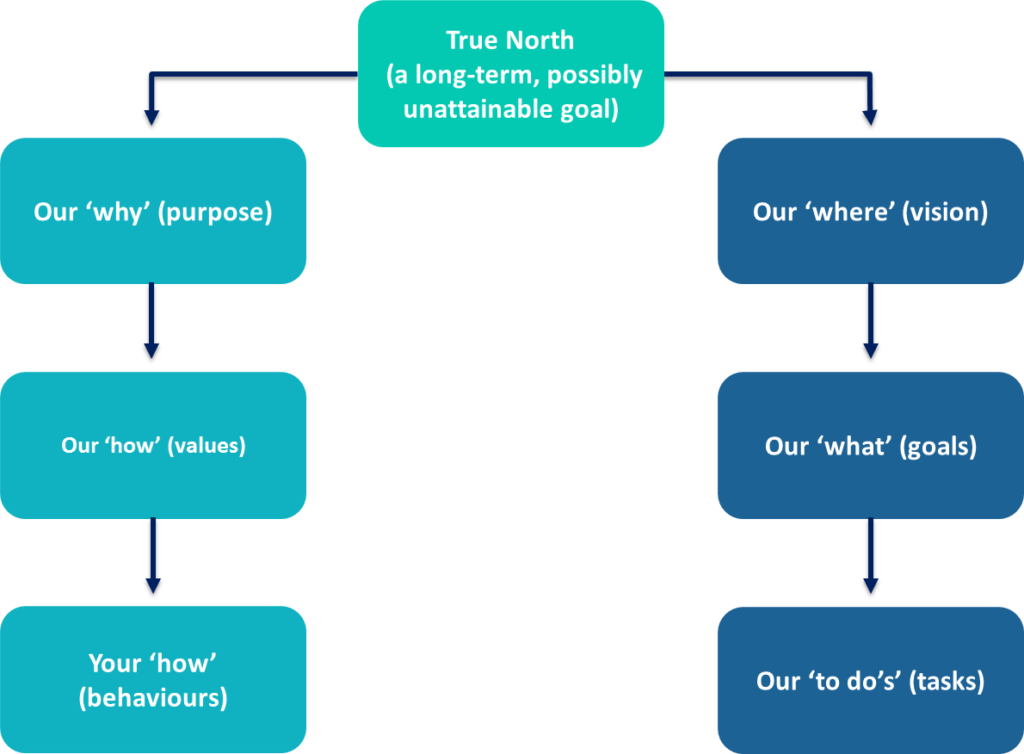Effectively communicating strategy can be one of the more tricky challenges facing an organisation. Go into too much detail and audiences glaze over pretty quickly as death-by-PowerPoint is inflicted upon them. Or pitch it at too high a level and no-one is any the wiser about what it means for them. Which, by the way, is the question that the majority of audiences are most interested in hearing the answer to.
In our experience, great strategy communication needs three elements:
- A clear framework
- A great story
- Leaders who interpret for their teams
1. A clear framework
It’s easy to bamboozle colleagues with mission statements, visions, values, behaviours and all the other management speak before you even get to the strategy piece. And it’s then completely confusing when there’s no apparent relationship between these things, and the strategy simply appears as if it’s in some kind of parallel universe.
To address this problem, we like to use this simple framework to make sense of the various elements, based on the work of our friend and collaborator, Kevin Murray, author of Communicate to Inspire.

The left side is the more emotive side of the framework that shapes beliefs and attitudes, the right side is the more tangible and rational, and the side where strategy neatly sits.
Together they will help the business on its journey towards the True North.
Sometimes all of these elements are in place, so the job is one of articulation rather than definition. Or it may be that you want to enlist the help of the organisation to fill in some missing pieces which can be great for building ownership. Or you may have a blank canvas that you need the leadership team to begin to complete…What matters is that all of it needs to be in place if the wider organisation is to make sense of what they’re being asked to do.
2. A great story
No matter how clear the strategy, without a story to carry it forward it will appear dry and remote. A great way around this is to find a story device that allows you to ‘unpack’ the strategy in terms that people in the business can relate to.
As an example, you could take a typical family and show how different members of it interact with your products or services. What are their frustrations? Which products do they love? Which other brands do they love and why? And how will their interactions change in the coming years thanks to your new strategy? Or it could be a year-in-the-life of a customer, or a prospect or even a competitor.
The point is such a device makes it easier to communicate the strategy, but also a whole lot easier to understand. And it means the story can be told consistently across the organisation.
3. Leaders who interpret for their teams
‘This is all great, but what does it mean for me?’ is THE question that people want answered whenever there is a strategy announcement, but usually the announcement can’t answer that question. So it’s over to function and line leaders to make sense of it all.
This is about equipping them with the content (the story device, Q&As, redlines for discussion etc.), the skills and the materials they need to land the strategy with their teams. But this should only be the start of a conversation, one that will continue beyond the initial briefing and become a productive and engaging dialogue for all.
We have found this approach to be enormously valuable in helping colleagues in some of the world’s largest and most complex organisations to get their arms around the strategic direction of the company. But it also works for those leading divisions or functions, as it helps to create a sense of connection and contribution, and brings the intangible to life. Without it, leadership becomes an exercise in explaining what we need to do. Get this right, and it gives leaders the license to empower and unlock.
